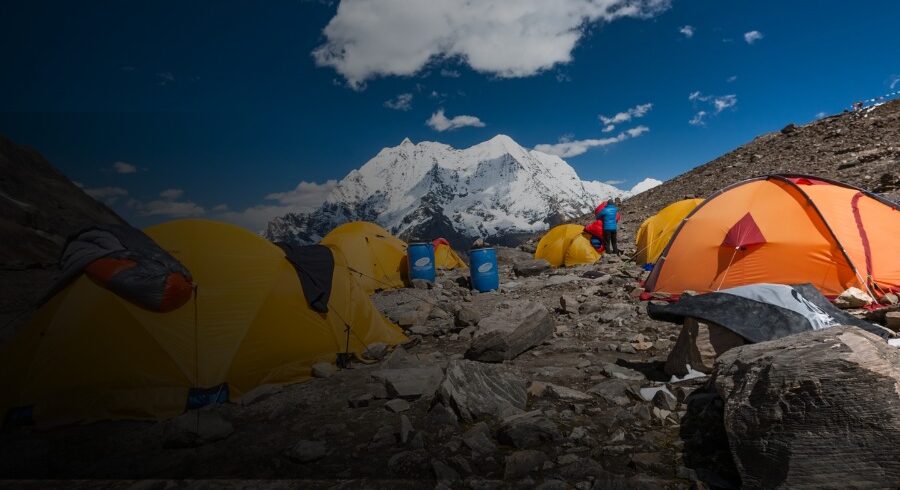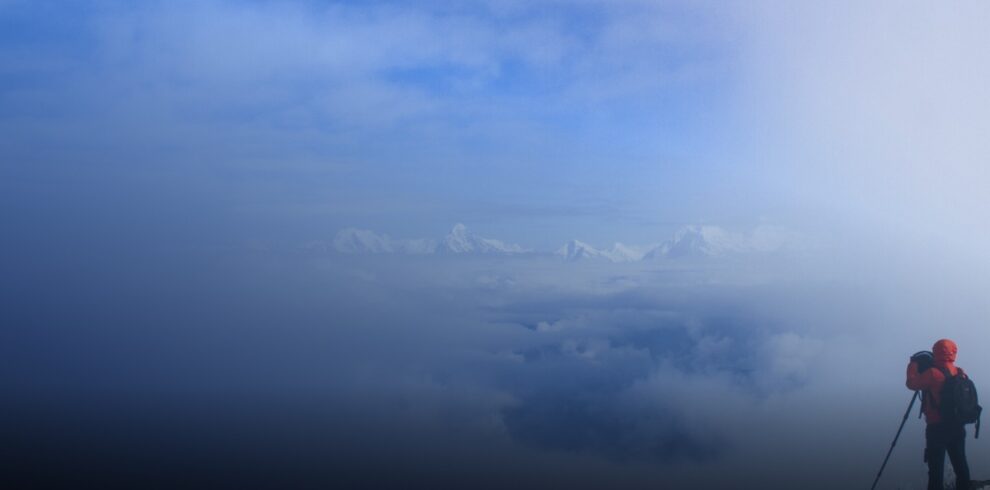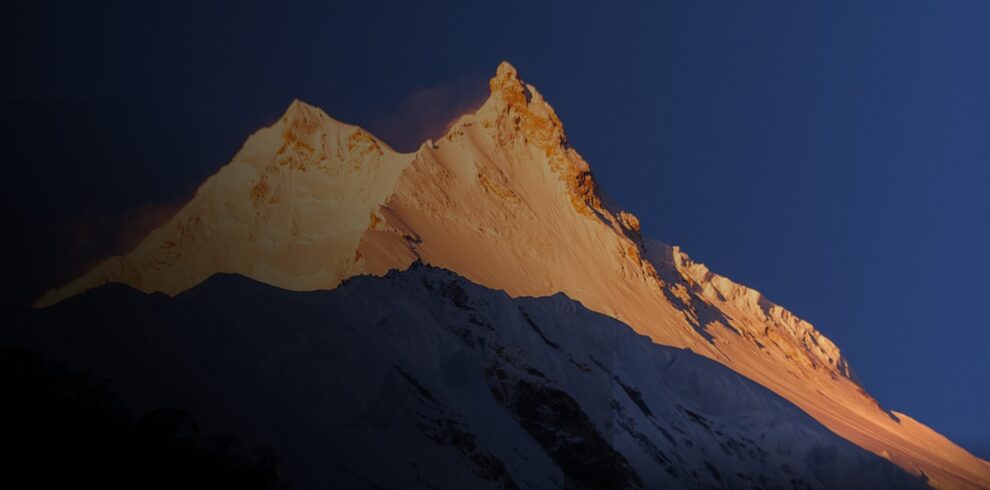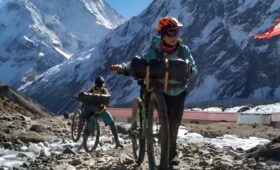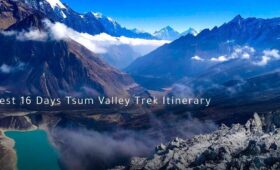Discovering Manaslu
The Manaslu region is a geographical marvel that rivals the beauty of the Himalayas in western Nepal. The region is home to the Manaslu Conservation Area, a sanctuary established in 1998 covering 1,663 square kilometers. This area is a natural paradise with diverse ecosystems, including alpine meadows and majestic glaciers surrounded by culturally rich landscapes.
The Manaslu trek map helps trekkers ascend and descend safely in unpredictable circumstances. Traveling this unexplored territory will leave you mesmerized by its untouched beauty and a sense of tranquility that awaits your discovery. The Manaslu Summit stands at 8,163 meters, offering a one-of-a-kind adventure experience. Picture a scenery with majestic snow-capped peaks stretching towards the heavens with air-filled refreshing essence of untouched wilderness.
This conservation area embodies this marvel, showcasing Nepal’s dedication to safeguarding its precious natural heritage. It serves as a protector, preserving the fragile harmony of nature for future generations. It is a sanctuary for a wide range of plant and animal species, offering a vibrant display of colorful rhododendrons and the elusive presence of the snow leopard.
The Manaslu Trek is considered a crown jewel of the region and offers a breathtaking panorama. Imagine yourself journeying through lush valleys, crossing pristine rivers, and climbing up to lofty mountain passes that reveal unmatched views. The terrain ranges from dense forests to desolate landscapes, ensuring a trekking adventure that is both diverse and thrilling.
When you enter this unknown area, prepare yourselves for a journey that goes beyond the usual. This region is more than just a place to visit; it’s an opportunity to connect with nature in its most pristine state. Embark on an unforgettable adventure that will leave a lasting impression on your spirit. Whether you are attracted to the thrill of reaching the summit or the tranquility of the trekking paths, it welcomes you to discover its secrets and establish a profound bond with the hidden treasure of Nepal’s western wilderness.
Traveling the Manaslu region is like a captivating expedition through a diverse ecosystem. Manaslu stands out not only for its geographical beauty but also for the cultural richness of its landscape. The local communities, such as the Gurungs and Tamangs, play a significant role in creating the region’s diverse cultural tapestry. The paths meander through picturesque villages adorned with monasteries and prayer flags with a glimpse into spiritual customs and the welcoming nature of locals.
As you immerse yourself in this cultural mosaic, you’ll also find that trekking in the Manaslu region offers excellent value in comparison to other popular trekking destinations in Nepal. The trip cost of the Manaslu Circuit varies depending on factors such as the duration of the trek, the services included, and the season of travel. However, on average, a 14 to 18-day trekking package includes permits, accommodation, meals, and guide services that can range from $1000 to $2000 per person.
The Manaslu trek cost may seem higher compared to other treks in Nepal, but it’s important to consider that the Manaslu offers a more remote and pristine trekking experience with fewer crowds and a closer connection to nature. Additionally, the cost includes permits to enter the restricted area, which helps preserve the region’s natural beauty and support local communities. Hence, If you’re seeking an unforgettable trekking adventure that blends cultural immersion, stunning scenery, and excellent value for money, Manaslu Circuit is the perfect choice.
Attractions in Manaslu
Valley
Mountain Peaks
Unique Landscapes
Unique Features of Manaslu
Distinctive Characterstics
Photography Expedition
Emphasis on Unspoiled Nature
Community-Led Conservation
The Manaslu Conservation Area (MCA) exemplifies innovative community-led conservation. Local residents play an active role in managing and safeguarding the region, preserving both its natural wonders and cultural legacy. This collective effort not only protects the environment but also empowers the residents, fostering a sense of ownership and responsibility for their cherished home. Through this collaborative approach, the MCA becomes a model where the community's active engagement ensures the ongoing preservation of the region's rich natural and cultural heritage.
Sustainable Tourism Practices
The MCA adopted Tips for sustainable trekking in Manaslu in order to minimize the impact on its fragile ecosystem. It has implemented strict guidelines for waste management, responsible trekking, and eco-friendly accommodations to maintain a harmonious balance between providing an exceptional trekking experience and preserving the pristine beauty of the region for future generations. This commitment ensures that the area's allure remains unaffected by the negative effects of tourism, allowing visitors to fully immerse themselves in the natural wonders of the Manaslu Conservation Area while preserving its ecological integrity.
Biodiversity Research and Monitoring
The MCA focuses on understanding and managing the biodiversity of the region, with a particular emphasis on ongoing research projects. These initiatives systematically track changes in plant and animal life, providing important information about the overall health of the ecosystem. By using data to guide their actions, conservationists can make informed decisions and develop effective strategies to protect the diverse biodiversity of the Manaslu region. This commitment demonstrates a proactive approach to preserving the abundant and unique range of plants and animals that contribute to the ecological equilibrium of the area.
Flora Diversity
The diverse elevations of Manaslu support a wide variety of plant life, resulting in a lush environment. The lower regions are home to vibrant forests filled with rhododendron, oak, and pine trees, while the higher altitudes display beautiful alpine meadows. This habitat is a paradise for botanists and nature lovers, as it is teeming with endemic plant species. The Manaslu Conservation Area boasts a rich botanical tapestry, providing a captivating landscape for exploration and attracting those interested in discovering the unique and diverse flora that contributes to the area's ecological wealth.
Iconic Fauna
The Manaslu Conservation Area is a sanctuary for iconic Himalayan wildlife, providing protection for elusive animals such as the snow leopard, red panda, Himalayan tahr, and musk deer in its untouched mountains. Moreover, the region is home to a variety of bird species, including rare birds like the vibrant Himalayan Monal, which contribute to the area's diverse avian population. Strong conservation efforts are implemented to safeguard these extraordinary species from dangers like poaching and habitat destruction, ensuring the preservation of their natural habitats in the pristine landscapes of the Manaslu mountains.
Endangered Species Protection
The Manaslu Conservation Area plays a vital role in protecting endangered species such as the red panda and snow leopard. Conservation efforts focus on preserving their habitats, reducing conflicts between humans and wildlife, and implementing successful anti-poaching strategies. These dedicated initiatives not only guarantee the survival of these endangered species but also make a significant contribution to maintaining the overall health and balance of the ecosystem in the Manaslu region.
Vegetation and Habitat Conservation
The Manaslu Conservation Area's primary goal is not only to protect individual species but also to preserve entire ecosystems. The focus is on maintaining the integrity of diverse habitats such as alpine meadows, forests, and wetlands. This holistic approach guarantees the continuous flourishing of the Manaslu region as a vibrant and interconnected web of life, where each ecosystem contributes significantly to sustaining the overall ecological balance. The MCA's commitment to safeguarding these diverse habitats demonstrates their dedication to creating a harmonious and thriving environment for both wildlife and the natural landscapes.
Remote Villages and Local Communities
Exploring Remote Villages
Samagaun:
Samagaon is located in the Himalayas and is a charming highlight along the Manaslu Circuit. The village has classic stone houses and prayer flags that dance in the mountain air, creating a peaceful atmosphere. Visitors can explore the Samagaon Monastery, which provides insight into the authentic religious traditions of the region. With its traditional architecture and serene ambiance, Samagaon invites visitors to immerse themselves in the cultural and spiritual richness of the remote villages along the Manaslu trek.
Samdo:
Samdo, a remote village located at a commanding altitude, possesses a unique allure. Surrounded by high-altitude deserts, this village allows trekkers to witness the resilient way of life embraced by its inhabitants. Mostly populated by Tibetan communities, Samdo contributes to the cultural diversity that defines the Manaslu region. With its awe-inspiring views and distinctive charm, this secluded village offers a glimpse into the cultural mosaic of the area, showcasing the determination and rich heritage of its residents amidst the backdrop of the Himalayan landscape.
Prok Village:
Prok Village is a scenic settlement located in the hills adorned with pine trees. It is surrounded by rugged mountains, offering trekkers a serene escape. The village contrasts the tranquility of the hamlet with the surrounding rugged terrain. Prok Village is known for its authenticity and simplicity, providing visitors with an authentic cultural encounter. They can experience genuine village life against the backdrop of picturesque landscapes. This peaceful haven is a delightful stop for trekkers seeking a respite in the heart of the Manaslu region, as it offers a genuine and unfiltered glimpse into the local culture.
Lifestyle and Traditions
Agricultural Practices:
In the remote villages of Manaslu, agriculture is the main focus, with terraced fields being the dominant feature. Locals grow crops such as barley, buckwheat, and potatoes. By participating in or observing these traditional farming methods, trekkers can experience the authentic local lifestyle firsthand. The cultivation of staple crops in the beautiful terrains becomes a cultural immersion for visitors, enabling them to connect with the people of the region and learn about the long-standing agricultural practices that support the communities along the Manaslu trekking route.
Traditional Crafts:
Along the Manaslu Expedition, there are many remote villages where skilled artisans engage in traditional crafts such as handwoven fabrics, detailed woodwork, and handmade pottery. These crafts reflect generations of artistic expertise and interacting with the local craftsmen allows trekkers to appreciate and comprehend the meticulous craftsmanship that defines the cultural essence of these communities. The intricately woven textiles, finely crafted wooden items, and handmade pottery serve as a tangible link to the cultural identity of the villages.
Festivals and Celebrations:
Life in the remote villages of Manaslu is characterized by traditional festivals that are deeply rooted in the local culture. Travelers who happen to be present during events such as Lhosar or Dashain are treated to lively celebrations, traditional dances, and rituals that provide a profound insight into the rich cultural heritage of the Manaslu communities. These festive occasions serve as a gateway to the vibrant traditions and customs of the region, giving trekkers a unique opportunity to witness and participate in the joyful and colorful celebrations that define the cultural fabric of the remote villages along the Manaslu trekking route.
Hospitality and Homestays
Warmth of Local Hospitality:
The Manaslu adventure is distinguished by the genuine warmth of local communities encountered along the trekking routes. Trekkers are warmly welcomed with authentic hospitality when enjoying a meal at a teahouse or engaging with villagers. The locals’ openness in sharing their stories and traditions not only enhances the trek but also adds a personal and heartfelt touch to the overall experience. The residents’ willingness to connect and offer insights into their way of life contributes to the unique and memorable encounters that define the spirit of hospitality in the heart of the Manaslu region.
Homestay Experiences:
To fully immerse in the local culture, some hikers choose to stay in homestays and experience authentic hospitality in the Manaslu region. By staying with a local family, they can gain a deeper understanding of daily life, customs, and traditions. In addition to sharing meals, trekkers also participate in the household’s daily activities, promoting a cultural exchange that goes beyond the trekking trail. Homestay options in Manaslu region enhances the overall experience, allowing for a close connection with the local way of life and providing a unique opportunity for cultural exchange and understanding in the heart of the Manaslu region.
Flora and Fauna of Manaslu
Flora Diversity
Fauna Diversity
Rare and Endangered Species Protected within Manaslu Conservation Area
Manaslu Trek Routes
Duration: 14-18 Days
Manaslu Circuit Trek
Duration: 14-17 Days
Tsum Valley Trek
Duration: 21-24 Days
Manaslu Tsum Valley Trek
Duration: 1 Day
Manaslu Helicopter Tour
Tsum Valley
Manaslu Photography Trek
Circuit Trek
Zen Trail of Manaslu
Cultural Diversity
The Manaslu region in Nepal is not only attractive to adventure enthusiasts looking for untouched nature, but also to those who are eager to explore the rich cultural diversity that is woven into the Himalayan landscape. Situated amidst the majestic peaks, Manaslu is home to various ethnic communities, which together create a vibrant tapestry of Himalayan heritage. As trekkers make their way through the trails, they are exposed to a colorful array of cultures, with each community contributing its own unique element to the overall narrative. This region serves as a testament to the harmonious coexistence of nature and human traditions, providing an enthralling journey where every step reveals a new chapter in the captivating story of Himalayan diversity.
Ethnic Diversity
Manaslu has a cultural mosaic that is shaped by the coexistence of diverse ethnic groups such as Gurungs, Tamangs, Sherpas, and Tibetans. The trekking trails are adorned with a captivating cultural tapestry created by the interplay of these traditions. Each village, from Samagaon to Samdo, serves as a living testament to the ethnic richness of the region, with ancient monasteries, fluttering prayer flags, and locals deeply rooted in age-old customs. This unique blend of cultures provides trekkers with an immersive experience, allowing them to gain insights into the distinct lifestyles and traditions that make Manaslu a vibrant and authentic destination.
Religious Practices
The communities in Manaslu are deeply influenced by their religious beliefs, which play a central role in their daily lives and festivities. Tibetan Buddhism is the predominant faith, as seen through the numerous monasteries spread throughout the area. Monks, dressed in their recognizable maroon robes, partake in rituals while the peaceful sounds of prayer wheels and chants fill the air. Visitors on treks are encouraged to witness these sacred practices, providing them with a glimpse into the profound spirituality that characterizes the region.
Festivals
The Manaslu Circuit Trek is a captivating trekking destination in the Gorkha district of Nepal. The Manaslu Circuit is renowned...
Timeless traditions set against a backdrop of snow-capped giants.
Bringing It All Together
While exploring the Manaslu region, one can witness not only a paradise for trekking but also a perfect combination of nature and diverse cultures. From the majestic mountains to the peaceful valleys, the untouched beauty of the Manaslu Conservation Area preserves rare biodiversity and cultural heritage. Trekking the renowned Manaslu Circuit or the serene Zen Trail offers a cultural immersion, where religious practices, vibrant festivals, and unique elements create an authentic experience. Whether exploring the Tsum Valley or reaching the Manaslu Base Camp through a helicopter tour, every step taken intertwines with the living story of the region. In this less crowded Himalayan sanctuary, professionalism meets warm hospitality, informative encounters with nature’s charm, and approachability is reflected in the friendly smiles of the locals. Manaslu is not just a destination; it is an invitation to discover the purest essence of the Himalayas, where traditions resonate against snow-capped peaks and each trek becomes a transformative journey into authenticity.


